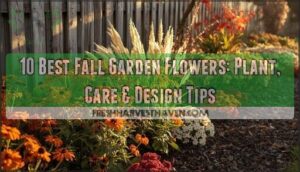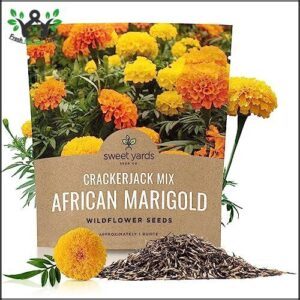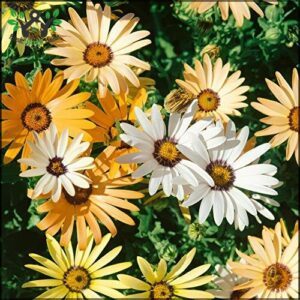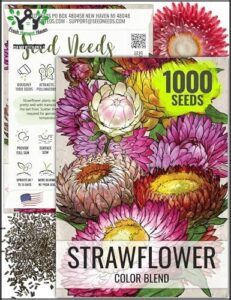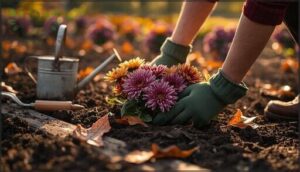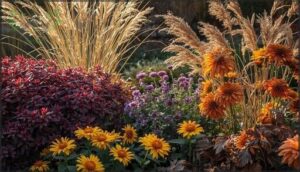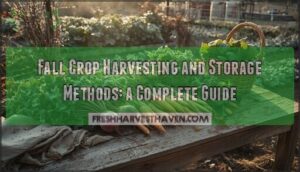This site is supported by our readers. We may earn a commission, at no cost to you, if you purchase through links.
Your fall garden doesn’t have to fade when summer ends. While most gardeners pack away their tools in September, the weeks between late summer and first frost offer a rare window when dozens of hardy annuals and perennials hit their stride. African marigolds unfurl 4-inch blooms in burnt orange. Black-eyed Susans attract monarchs through October. Strawflowers keep their papery petals intact long after the growing season ends.
The trick isn’t fighting the season—it’s working with plants that thrive as temperatures drop. You’ll need to match varieties to your light conditions, prep soil before the ground hardens, and time your planting so roots establish before winter. Done right, your beds can deliver color until the first hard freeze.
Table Of Contents
- Key Takeaways
- 10 Best Fall Garden Flowers
- 1. African Marigold Flower Seeds Mix
- 2. King Henry Purple Viola Seeds
- 3. Mixed Color Petunia Flower Seeds
- 4. Blue Pink Purple Hydrangea Seeds Mix
- 5. Mixed Color Heirloom Rose Seeds
- 6. African Daisy Flower Seed Mix
- 7. Beautiful Blanket Flower Seeds Mix
- 8. Blue Ageratum Flower Garden Seeds
- 9. Heirloom Strawflower Seed Mix
- 10. Black Eyed Susan Wildflower Seeds
- Choosing Fall Flowers for Sun and Shade
- Attracting Pollinators With Fall Flowers
- Planting and Caring for Fall Flowers
- Designing Colorful Fall Garden Beds
- Frequently Asked Questions (FAQs)
- What flowers grow best in autumn?
- What is the most popular flower in fall?
- What are the best perennials for fall blooming?
- What is the queen of the fall flowers?
- What flowers are good for fall garden?
- When should I start my fall garden?
- What flowers are in autumn season?
- What perennial plants bloom in the fall?
- When should I start my fall flower garden?
- What are the best perennial flowers for fall?
- Conclusion
Key Takeaways
- Fall flowers like African marigolds, black-eyed Susans, and strawflowers thrive in cooler temperatures and continue blooming until the first hard freeze, with proper timing (4-7 weeks before frost) allowing roots to establish before winter.
- Matching plants to light conditions is critical—full-sun varieties like blanket flowers need six-plus hours of direct sunlight, while shade-tolerant options like Japanese anemones and violas perform well in partial shade or dappled light.
- Late-season blooms provide essential nectar and pollen for pollinators preparing for winter, making pollinator-safe practices like eliminating chemical pesticides and grouping plantings at least three feet wide crucial for supporting bees, butterflies, and migrating birds.
- Successful fall gardening requires soil preparation with compost, strategic watering (twice monthly with deep saturation), low-nitrogen fertilizers applied after first frost, and frost protection methods like row covers when temperatures drop to the mid-30s°F.
10 Best Fall Garden Flowers
Fall flowers bring your garden to life when summer blooms start to fade. You’ll find options that thrive in cooler temperatures, handle light frosts, and keep color going until the first hard freeze.
Here are ten reliable varieties that perform well in autumn gardens.
1. African Marigold Flower Seeds Mix
African Marigold seeds deliver a splash of bold color to your fall gardening plans. These open-pollinated beauties germinate in 5 to 20 days at 70-75°F, then produce 4-inch blooms in deep oranges and golds by late summer through autumn.
You’ll get impressive blooming tips when you space plants 8 to 10 inches apart in well-drained soil with full sun. Deadheading spent flowers keeps seasonal blooms coming strong, and their pest-repelling scent makes them perfect companion plants.
With proper marigold care—consistent moisture during seed germination and moderate watering after—these heat-tolerant flowers thrive in garden designs from beds to containers, attracting pollinators while requiring minimal garden maintenance.
Best For: Gardeners who want large, colorful marigolds that bloom from summer through fall while attracting pollinators and naturally repelling garden pests.
- Large 4-inch blooms in vibrant oranges and yellows that flower continuously from late spring through autumn when deadheaded regularly
- Heat-tolerant and pest-repelling properties make them excellent companion plants that protect vegetable gardens from nematodes and harmful insects
- Over 10,000 open-pollinated heirloom seeds per 1-ounce packet provide exceptional value for multiple planting projects, beds, or containers
- Germination can be inconsistent, taking anywhere from 5 to 20 days, and some customers report plants that never produced flowers
- Blooming may take longer than the advertised 2-3 months, with full maturity actually requiring 70 to 85 days from planting
- Plant height varies significantly from 10 inches to 4 feet tall depending on variety and growing conditions, making garden planning unpredictable
2. King Henry Purple Viola Seeds
King Henry Purple Viola seeds bring deep violet-blue blooms with bright yellow centers to your fall garden design. These compact violas reach just 4-8 inches tall, perfect for containers and borders.
You’ll see germination in 7 to 21 days at 68°F, then enjoy frost-tolerant seasonal blooms down to 35°F across USDA zones 6-9. Their pollinator value shines—they feed 30 fritillary butterfly species and attract bees.
Plant care stays simple: space 4-6 inches apart in moist, well-draining soil, deadhead faded flowers, and watch them rebloom through cool fall weather while supporting garden wildlife.
Best For: Gardeners in zones 6-9 who want compact, frost-tolerant violas with deep purple blooms that attract pollinators to containers, borders, and small garden spaces.
- Blooms remain vibrant in cool weather down to 35°F and provide nectar for 30 butterfly species and bees
- Compact 4-8 inch height works perfectly in tight spaces like hanging baskets and small containers
- Self-seeds naturally and requires minimal maintenance beyond deadheading and occasional balanced fertilizer
- Seeds are powdery and easily displaced by wind, making initial planting challenging
- Germination takes 7-21 days at specific 68°F temperature, and first-year blooms aren’t guaranteed
- Flowering stops in heat above 75°F, requiring cutback and cooler temperatures to trigger rebloom
3. Mixed Color Petunia Flower Seeds
Mixed Color Petunia Flower Seeds deliver trumpet-shaped blooms in 5 to 8 distinct shades—from near-black purple to magenta and yellow—perfect for creative fall garden designs that reflect your style.
You’ll see germination in 7 to 14 days at 72–76°F, then enjoy continuous color until the first frost across USDA zones 3–8. These annuals spread 30–39 inches wide and reach 6–12 inches tall, ideal for hanging baskets or border color combinations.
Deadhead spent flowers regularly to keep fresh blooms coming through autumn. While pollinator visits average below other annuals, syrphid flies and bumble bees still appreciate red and coral petunia varieties in mixed plantings.
Best For: Gardeners in USDA zones 3–8 who want low-maintenance, cascading color for hanging baskets, borders, or ground covers from late spring through the first frost.
- Germination happens in 7–14 days at 72–76°F, with continuous blooms lasting 3–5 months until frost if you deadhead regularly.
- Mixed seed packets deliver 5–8 distinct color varieties in one planting, creating eye-catching displays that spread 30–39 inches wide.
- Compact 6–12 inch height and trailing habit work well in hanging baskets, window boxes, and garden borders with minimal maintenance.
- Pollinator visits average below 0.08 per minute—significantly lower than begonia and other popular annuals in field trials.
- Customer reviews report mixed germination success, with some experiencing no blooms at all despite following planting instructions.
- Small seed packet quantities and quality concerns appear in multiple buyer reports, raising questions about overall value for money.
4. Blue Pink Purple Hydrangea Seeds Mix
If bold, year-after-year color is your thing, Blue Pink Purple Hydrangea Seeds Mix brings personality and staying power. With proper seed germination—think cold stratification and a steady hand with moisture—these fall flowers reward patience.
Flower color variation is pure garden magic: tweak soil pH levels for blooms that range from moody blue to hot pink.
As true perennials, hydrangeas thrive in partly shaded garden spots, adding easy charm to your autumn space and keeping the show going well after other flowers quit.
Best For: Gardeners who want colorful perennial blooms that adapt to different soil conditions and return year after year with minimal fuss.
- Perennial flowers deliver lasting beauty across multiple seasons without replanting, making them cost-effective for long-term gardens.
- Soil pH adjustments let you control bloom colors from blue to pink to purple, offering flexibility in your garden’s color palette.
- Hardy plants thrive in various climates and partly shaded spots, making them adaptable to different garden conditions.
- Mixed customer feedback reports poor germination rates, with some seeds failing to sprout at all.
- Seeds require cold stratification for 4-6 weeks and careful moisture management, which demands patience and attention during the germination phase.
- Success isn’t guaranteed due to potentially damaged or dry seeds, leading some buyers to view the purchase as a waste of money.
5. Mixed Color Heirloom Rose Seeds
Surprise is the name of the game with Mixed Color Heirloom Rose Seeds—each bloom unfolds with colors you won’t predict, thanks to the genetic lottery of seed propagation. Seed stratification is non-negotiable: cold-treat seeds for two to three months to boost rose seed germination, which usually hovers between 10% and 30%.
These perennial flowers demand patience and proper heirloom rose care—think loamy, well-drained soil, six-plus hours of sunlight, and consistent moisture during fall rose planting.
Once established, your rose garden design gains timeless fragrance and heritage charm that modern hybrids can’t replicate, making flower gardening feel like a rebellion against cookie-cutter blooms.
Best For: Patient gardeners who love the thrill of unpredictable blooms and want to grow fragrant, heritage roses from scratch while embracing the challenge of low germination rates.
- Heirloom genetics deliver intense fragrance and historic charm that modern hybrid roses can’t match, perfect for traditional garden aesthetics.
- Perennial growth means your roses return year after year once established, offering long-term value despite initial germination hurdles.
- Genetic variability creates a one-of-a-kind garden with surprise colors and forms, making each bloom a unique discovery.
- Germination rates typically hit only 10-30%, meaning many seeds won’t sprout even with proper cold stratification for two to three months.
- Seedlings may take a year or longer to germinate and won’t reliably match parent plant colors or traits due to genetic recombination.
- Requires specific conditions—loamy soil, six-plus hours of sunlight, consistent moisture, and vigilant fungal disease management—making them high-maintenance for beginners.
6. African Daisy Flower Seed Mix
With 5,000 seeds in the Outsidepride mix, you’ll get a kaleidoscope of African Daisy varieties that open wide in sunlight and close at dusk—nature’s own clock for your fall flowers.
Sow directly after frost in well-drained, sandy soil with full sun exposure; germination hits in 10 to 21 days at 60 to 70°F. These drought-tolerant seasonal flowers thrive in USDA zones 3-10, making flower planting almost foolproof for garden design beginners.
Deadhead spent blooms to keep the show running through fall, and skip heavy watering—African Daisy flower care rewards neglect more than fussing, perfect for rebellious gardening tips.
Best For: Gardeners seeking low-maintenance, drought-tolerant flowers that attract pollinators and add vibrant color to borders or containers in USDA zones 3-10.
- Easy to grow with minimal care—thrives in dry conditions and well-drained soil, making it ideal for xeriscaping and beginner gardeners.
- Attracts bees and butterflies while offering a dynamic daily display as flowers open in sunlight and close at dusk.
- Versatile planting options with 5,000 seeds providing excellent coverage for borders, containers, or wildflower gardens across multiple zones.
- Mixed germination success reported by customers, potentially due to environmental factors or improper soil conditions.
- Sensitive to overwatering and high humidity, producing more foliage and fewer blooms in wet climates.
- Does not transplant well once established, requiring careful initial placement and direct sowing for best results.
7. Beautiful Blanket Flower Seeds Mix
You’ll harvest show-stopping 4-inch blooms from early summer straight through fall with Seed Needs’ Blanket Flower seeds—a perennial powerhouse that laughs at drought and pulls pollinators like a magnet.
Soil preparation is simple: scatter seeds in well-drained ground after your last frost, barely cover them (1/4 inch max), and watch germination kick in at 60-70°F within weeks. These fall flowers thrive in USDA zones 3-10 with full sun, making flower planting a breeze for any garden layout.
Skip fussy watering once established—their taproot does the heavy lifting—and deadhead spent blooms to stretch those blooming patterns into November.
Best For: Gardeners in zones 3-10 who want low-maintenance, drought-tolerant perennials that attract pollinators and bloom continuously from summer through fall.
- Produces vibrant 4-inch blooms from early summer through late fall, providing months of color with minimal effort once established.
- Extremely drought-tolerant with a deep taproot system, requiring little to no watering after the first season—perfect for xeriscaping and dry climates.
- Acts as a pollinator magnet, drawing butterflies, bees, hummingbirds, and other beneficial insects to support garden biodiversity.
- Germination can be inconsistent, with some users reporting low or failed germination rates even under proper conditions.
- Prone to fungal diseases and root rot if soil drainage is poor or watering is excessive during establishment.
- May underperform or struggle in extreme heat despite drought tolerance, and weeds can compete aggressively if seedbed prep isn’t thorough.
8. Blue Ageratum Flower Garden Seeds
You’re looking at a pollinator magnet that fills garden designs with fluffy blue blooms from spring until frost—Cozy Crib’s Blue Ageratum thrives as an annual in most zones and a perennial in 10-11.
Seed germination happens in roughly two weeks at 75-80°F when you barely cover seeds (⅛ inch deep) in well-drained soil with a pH between 5.0 and 6.0.
These fall flowers tolerate light shade, attract bees and butterflies throughout their 120-150 day blooming window, and work beautifully in flower arrangements, borders, or containers.
Space plants 9-12 inches apart after soil preparation, water weekly once established, and enjoy continuous color alongside your perennials and annual flowers.
Best For: Gardeners seeking long-blooming, pollinator-friendly flowers for borders, containers, or cutting gardens in zones 6-11.
- Attracts bees, butterflies, and beneficial insects with continuous blue blooms from spring through fall frost (120-150 days).
- Heat-tolerant and easy to grow with quick germination (7-10 days at 75-80°F) and minimal pest issues.
- Versatile planting options—works in full sun or light shade, suitable for beds, pots, or bouquet arrangements.
- Some customers report receiving fewer seeds than expected or inaccurate seed counts in packages.
- Requires consistent watering during establishment and prefers specific soil conditions (pH 5.0-6.0, well-drained).
- Occasional reports of incorrect flower colors growing or weed seeds mixed in packages instead of Ageratum.
9. Heirloom Strawflower Seed Mix
Seed Needs’ Heirloom Strawflower Seed Mix brings papery, “forever” blooms in white, yellow, red, pink, and orange—perfect for fresh-cut arrangements and dried designs that hold color for months.
These open-pollinated seeds grow 36-inch plants in Zones 3-10, germinating in 5-20 days when you sow them ¼ inch deep after your last frost in well-draining soil (pH 6.0-7.0). Space them 12-18 inches apart, water moderately once established, and cut blooms regularly to encourage more buds.
Butterflies, bees, and ladybugs will thank you for the late-season nectar while you’re stocking up on gorgeous, low-maintenance fall flowers for your autumn garden.
Best For: Gardeners who want vibrant, long-lasting cut flowers for fresh or dried arrangements and are comfortable with small seeds and variable germination.
- Papery blooms hold their color for months when dried, making them perfect for year-round arrangements and craft projects.
- Attracts beneficial pollinators like bees, butterflies, and ladybugs with late-season nectar when other flowers have faded.
- Hardy and heat-tolerant plants thrive in Zones 3-10 with minimal care once established, and regular cutting encourages more blooms.
- Germination rates can be inconsistent, with some users reporting poor or no sprouting despite following proper planting procedures.
- Seeds are extremely small and require careful handling during planting to avoid overcrowding or loss.
- Need warm soil temperatures (above 60°F) and specific conditions for successful germination, which may limit planting windows in cooler climates.
10. Black Eyed Susan Wildflower Seeds
Sweet Yards’ Black Eyed Susan seeds deliver over 100,000 GMO-free seeds in one extra-large packet—enough to transform 250 square feet into a pollinator magnet that blooms for months.
These wildflowers germinate in two weeks, grow 12-36 inches tall across USDA Growing Zones 3-9, and attract monarchs, native bees, and finches. They offer ecological benefits like erosion control and garden restoration support.
Space them 12-16 inches apart in well-draining soil and water moderately once established. Watch your fall flowers multiply year after year through natural reseeding—perfect for low-maintenance perennials that fuel seed germination and wildflower care without fuss.
Best For: Gardeners seeking a low-maintenance, pollinator-friendly wildflower that naturalizes across diverse climates and provides months of vibrant blooms with minimal care.
- Over 100,000 seeds cover 250 square feet, germinate in two weeks, and attract monarchs, native bees, and finches while supporting erosion control and habitat restoration.
- Thrives in USDA Zones 3-9 with drought tolerance once established, reseeds naturally for year-after-year blooms, and adapts to varied soil types and light conditions.
- Extra-large premium packaging includes full planting instructions, reusable zipper, and grow guarantee with refund/replace policy backed by personal gardening advice.
- Mixed germination success reported by customers, with some experiencing no growth—likely due to cold stratification requirements not clearly stated in product information.
- Inconsistent customer service responses to seed quality issues, and some packets contained seed variety discrepancies or lower-than-expected viability rates.
- Susceptible to powdery mildew, snails, slugs, and wildlife grazing (deer consume up to 36% of seedlings), with silvery checkerspot caterpillars reducing seed yield by up to 50% in infested plants.
Choosing Fall Flowers for Sun and Shade
Your fall garden’s success hinges on matching flowers to the light conditions you’ve actually got. Some plants crave full sun while others prefer shade, and picking the wrong one means lackluster blooms or leggy, struggling growth.
Here’s how to choose varieties that’ll thrive in your specific garden spots.
Full Sun-Loving Varieties
When planning your garden layouts, prioritize sunflower and other full sun bloomers that demand at least six hours of direct sun exposure daily.
Black-Eyed Susan thrives in USDA growing zones 3–11, reaching three feet with minimal drought tolerance concerns once established. Blanket Flower delivers vibrant fall bloomers through autumn with outstanding drought tolerance.
These perennials require well-drained soil preparation enriched with organic matter for ideal sunflower care and sustained fall flowers performance. For ideal results, consider the fall gardening tips to improve your garden’s beauty.
Shade-Tolerant Fall Flowers
Not all autumn gardens bask in full sunlight—shaded spots deserve fall bloomers too. Japanese anemones and Astilbe thrive in partial to full shade, producing feathery plumes and delicate blooms until frost. Heuchera (Coral Bells) and Violas deliver colorful foliage with strong frost resilience in USDA zones 4–9. These low light plants require moist, humus-rich soil for ideal shade flower care. Asters and Joe Pye Weed also adapt to dappled shade, supporting pollinators while enhancing your shade garden design.
For successful shade gardening, understanding shade flower basics is essential for plant selection and care.
Plants for Mixed Light Gardens
Fluctuating light—2 to 6 hours of filtered or dappled sun—presents unique opportunities for mixed light plants. Japanese anemones bloom from summer into fall, reaching 3 feet with delicate pink or white flowers. Oakleaf hydrangeas handle part sun beautifully, delivering dark pink blooms and burgundy foliage in USDA zones 5–9. Chrysanthemums and pansies adapt to varying sun exposure, lasting until hard frost.
- Japanese Anemones: Summer-to-fall bloomers for partial shade, up to 3 feet tall
- Oakleaf Hydrangeas: 6-8 feet, pink flowers, burgundy fall color
- Fuchsias: Bloom spring to frost in light shade, groundcovers to 10-foot shrubs
- Chrysanthemums & Pansies: Adaptable fall bloomers tolerating mixed conditions
Attracting Pollinators With Fall Flowers
Fall flowers aren’t just pretty—they’re lifelines for pollinators preparing for winter. Bees, butterflies, and migrating birds depend on late-season nectar and pollen when other food sources disappear.
Here’s how to turn your autumn garden into a pollinator haven while keeping your plants healthy and chemical-free.
Bee-Friendly Fall Blooms
Bees depend on late-season nectar and pollen to fuel their colonies through winter, making your pollinator garden essential in fall. Plant goldenrod and asters—they’re prolific pollen sources that attract diverse native bees.
Add sedum, sunflower, zinnias, and nasturtium for staggered bloom times. Purple and yellow fall bloomers work best; bees prefer these hues when building nutrition reserves before frost.
Flowers for Butterflies and Birds
Your fall garden becomes a wildlife habitat when you plant the right nectar sources and seed producers. Goldenrod fuels monarch migration, while Black-Eyed Susans and Zinnias attract painted ladies and swallowtails. Joe Pye Weed and Butterfly Bush extend bloom through September.
For bird-friendly plantings, add sunflowers and native asters—their seed heads feed finches and sparrows into winter. Nasturtiums provide accessible nectar for hummingbirds passing through.
These pollinator plants create layered butterfly gardens that support migration routes and overwinter populations.
Pollinator-Safe Gardening Tips
Protecting pollinator health starts with eliminating chemical pesticides, which cause 95% of pollinator deaths in home gardens. Your eco gardening approach should prioritize sustainable practices that keep bee-friendly visitors safe while enjoying fall flowers like Nasturtium, Butterfly Bush, and Joe Pye Weed.
Follow these garden safety essentials:
- Group plantings 3+ feet wide to improve foraging efficiency
- Provide shallow water dishes with pebbles to prevent drowning
- Leave undisturbed soil patches where 70% of native bees nest
These pollinator garden strategies create habitat complexity without harmful interventions.
Planting and Caring for Fall Flowers
Getting your fall garden to thrive takes more than dropping seeds in the ground and hoping for the best. You’ll need to prep your soil, nail down a watering routine, and have a game plan for when frost threatens.
Here’s what you need to know to keep your autumn blooms looking strong all season long.
Preparing Soil for Autumn Planting
Think of soil prep as setting the dinner table before your fall flowers arrive—you want everything ready so they can dig in right away. Start by testing your soil 4–6 weeks before planting, aiming for a pH between 6.1 and 6.9 to support nutrient uptake across USDA growing zones.
Mix 1–3 inches of compost into the top 6–12 inches to boost water retention and root development. Light tillage improves oxygen flow, but don’t overdo it—excessive disruption can damage soil structure.
These preparation techniques give your fall flowers the foundation they need to thrive through cooler months.
Watering and Fertilization Tips
Your fall flowers need different care than summer blooms—cooler temps change how you handle soil moisture and nutrients. Here’s your game plan for watering schedules and fall fertilization:
- Water twice monthly in well-drained soil, saturating thoroughly in early morning to support root growth without risking fungal issues.
- Choose low-nitrogen fertilizers with higher phosphorus and potassium after the first frost to strengthen roots, not foliage.
- Check soil needs by testing the top 2 inches—if it’s dry, water deeply; if moist, skip it to prevent root rot.
- Time your fall fertilization in late October or early November, following with deep watering for ideal nutrient absorption.
These plant care tips and gardening advice prepare your blooms for winter while avoiding overwatering that weakens roots.
Protecting Blooms From Early Frost
When overnight lows dip into the mid-30s°F, it’s time to act—tender annuals won’t survive a hard freeze between 28°F and 25°F without help. Use frost protection methods like row covers elevated on stakes to trap ground heat, or relocate potted tropicals indoors before temperatures drop.
Cold frame gardening and season extension techniques keep blooms thriving in USDA growing zones where early frost threatens, especially in frost pockets on low ground where cold air settles.
Designing Colorful Fall Garden Beds
Creating a fall garden that stops people in their tracks isn’t about following a formula—it’s about playing with what catches your eye. The key is mixing rich colors, varied textures, and surprising layers that give your beds dimension from every angle.
Here’s how to arrange your fall blooms and foliage so your garden feels intentional, not random.
Combining Textures and Colors
Texture contrast and color harmony turn your autumn garden from predictable to unforgettable. Pairing smooth, glossy blooms against feathery grasses or fuzzy foliage creates garden depth that keeps eyes moving through your landscape design.
Here’s how to build visual interest:
- Mix surface textures: Combine fleshy ‘Autumn Joy’ stonecrop with wispy switchgrass for floral arrangements that feel alive
- Play with fall palette contrasts: Place purple asters beside yellow coneflowers—complementary colors that naturally intensify each other
- Layer coarse and delicate: Pair rough seed heads with soft petals to add dimension your fall flowers deserve
This approach makes small spaces feel expansive while reflecting natural autumn ecosystems in your garden design ideas.
Layering With Autumn Foliage and Berries
Beyond texture interplay lies another layer of fall magic: stacking autumn foliage with berry-producing shrubs. You’ll achieve visual harmony by pairing purple callicarpa berries against yellow spiraea leaves—a proven combo that extends color displays six to eight weeks.
This seasonal layering creates ecological balance too, since winterberry and viburnum berries feed migratory songbirds through November.
Plant ornamental grasses like switchgrass behind sedum and asters, then tuck berry shrubs at mid-height for depth that makes your autumn garden feel professionally designed.
Creative Layout Ideas for Fall Displays
Once you’ve paired foliage with berries, it’s time to get bold with your fall decor layout. Reclaimed wheelbarrows or galvanized tubs—used in 47% of standout autumn displays—make striking focal points when filled with seasonal themes like mums and asters.
Layer vertical trellises behind swaths of single-variety plantings for depth, then add garden lighting to extend your outdoor space into evening hours. These floral arrangements blend autumn flower arrangements with practical garden decor ideas, creating seasonal landscape design that feels authentic rather than staged.
Frequently Asked Questions (FAQs)
What flowers grow best in autumn?
Flowers that flourish during cooler months include asters, chrysanthemums, sedum, and marigolds—all prized for their vibrant autumn colors and frost tolerance.
These fall blooms thrive in zones 4–9, offering reliable seasonal gardening options that extend your display well into October.
What is the most popular flower in fall?
Chrysanthemums, or mums, hold the top spot as the most popular fall flower globally.
Their adaptability, extended bloom durations, and wide range of garden colors make them essential seasonal choices for autumn displays.
What are the best perennials for fall blooming?
Top perennials for fall blooms include Asters, Sedum, and Chrysanthemums—all thriving in zones 3-9 with full sun.
Rudbeckia and Echinacea deliver late-summer color through frost, reaching 2-4 feet tall while attracting pollinators during their active blooming seasons.
What is the queen of the fall flowers?
Many gardeners call chrysanthemums the queen of fall flowers.
Mums dominate autumn displays with over 140 award-winning cultivars, 13 distinct bloom forms, and colors spanning red, orange, yellow, purple, pink, and white—offering unparalleled variety for seasonal garden design.
What flowers are good for fall garden?
You’ll get gorgeous fall blooms from mums, asters, and sunflowers—these perennials deliver vibrant garden colors perfect for seasonal planting.
Pansies and African marigolds work beautifully in autumn landscaping, while creative flower arrangements can showcase mixed textures and heights for stunning fall displays.
When should I start my fall garden?
Start your fall garden 4 to 7 weeks before your first expected frost date—usually late August through early September in most zones.
Soil temperature should be between 55°F and 75°F for ideal germination.
Check your USDA growing zone and local frost date for precise timing.
What flowers are in autumn season?
Autumn gardens come alive with chrysanthemums, asters, sedums, and black-eyed Susans—fall blooms that paint your landscape in warm seasonal colors.
These perennial and annual flowers thrive through the first frost, supporting autumn garden design while attracting pollinators during their late-season migration.
What perennial plants bloom in the fall?
Asters, Garden Mums, and New England Asters are reliable perennial bloomers for fall color.
Sedum, Russian Sage, and Black-Eyed Susans also deliver seasonal colors through first frost, supporting pollinators during migration.
When should I start my fall flower garden?
Think of fall planting like catching the last train—you’ll want to hop on 4 to 6 weeks before your first frost date. That timing lets your fall flowers sink roots while soil temperature stays between 60°F and 70°F.
Check your climate zone’s frost dates and garden planning schedule to nail the sweet spot for fall gardening tips and seasonal gardening success.
What are the best perennial flowers for fall?
Top perennial choices include Asters, which bloom September through November in zones 4–8, and Sedum ‘Autumn Joy’, flowering through frost in zones 3– Chrysanthemums deliver vibrant seasonal colors from late September into early November.
These hardy fall blooms require minimal perennial care while adding lasting garden design appeal.
Conclusion
Most gardeners assume fall means shutting down—but the best fall garden flowers prove otherwise. When you plant marigolds, violas, and black-eyed Susans in late summer, you’re betting against dormancy and winning. These blooms don’t just survive cooler nights; they thrive in them, delivering saturated color while neighboring gardens fade to brown.
Prep your soil now, match varieties to your light, and you’ll have monarchs visiting in October and strawflowers holding their petals past Thanksgiving. Your fall beds won’t need coaxing—they’ll flourish on their own terms.
- https://www.ruralsprout.com/perennials-for-fall-color/
- https://thursd.com/articles/data-driven-insights-on-flowers-and-plants-for-the-fall-season
- https://www.bhg.com/fall-blooming-perennials-11812229
- https://bloomranchofacton.com/pages/what-are-the-best-flowers-to-plant-in-the-fall-great-autumn-garden-plant-and-blooms
- https://extension.psu.edu/native-perennials-for-fall/

